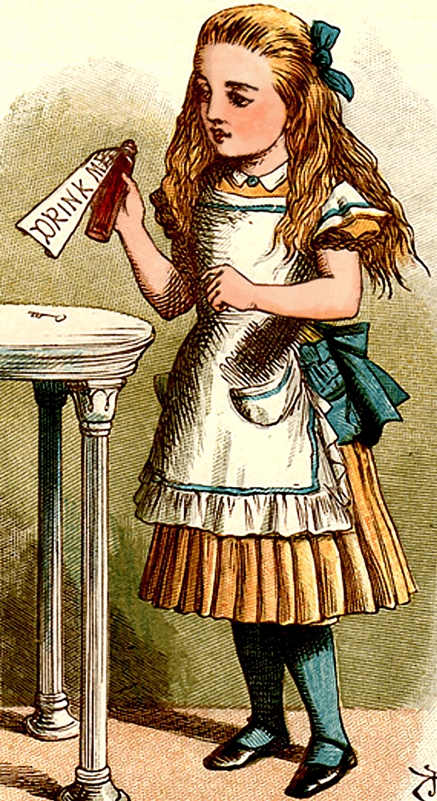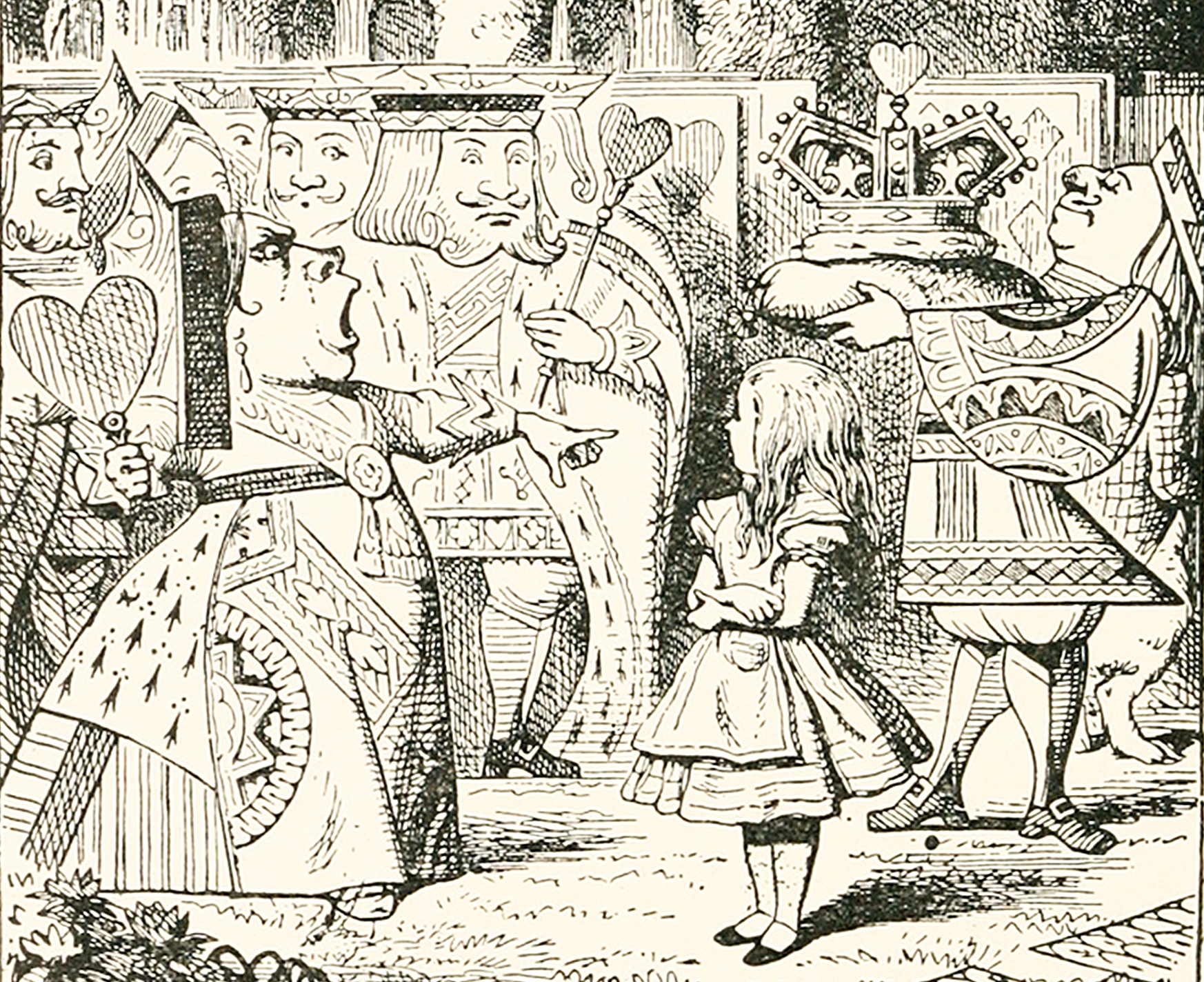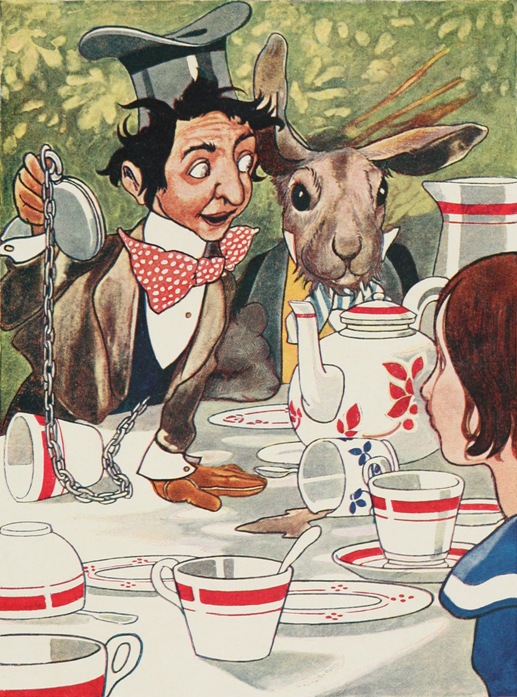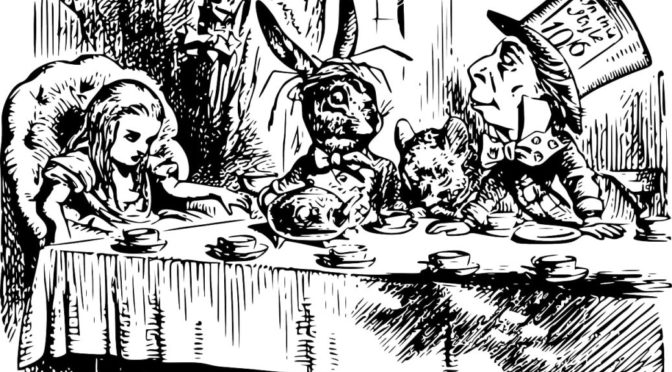Perhaps It’s Time to Believe the Impossible
By
Cognitive Dissonance
"Alice laughed: "There's no use trying," she said; "one can't believe impossible things." "I daresay you haven't had much practice," said the Queen. "When I was younger, I always did it for half an hour a day. Why, sometimes I've believed as many as six impossible things before breakfast." - Alice in Wonderland.
It is often said, usually by those who wish to “educate”, control and manipulate us, that we are defined by what we believe. I submit it’s the other way around. We are defined, or more accurately confined, by what we disbelieve and think impossible, or at a minimum, improbable.
Once we consign something to the impossible, unbelievable, farfetched, unlikely, preposterous and unreal cognitive file, rarely, if ever, do we fish it back out of the garbage bin for reassessment and reconsideration. And why would we do so since it clearly belonged there to begin with, otherwise we never would have discarded it in the first place.
That right there is a perfect example of circular logic and emotionally comforting thinking.
From the point in time when non-religious standardized thinking was institutionalized, more commonly known as the scientific revolution of the 16th and 17th centuries, we have been conditioned to believe everything and anything can (eventually) be cataloged, quantified, qualified and confirmed…or denied. More importantly, the scientific method insists “real” truth can only be verified by way of uniform methods that produce repeatable results.
When dancing on the fringe, this mindset requires the use of measuring instruments not yet invented or even conceived of when pushing the boundaries of accepted thought and “reality”. If one disbelieves something, or at best thinks it highly improbable, what real incentive does that person, entity or institution have to pursue that line of thought. The answer, of course, is little to none. This leaves cutting edge explorations to those who are both brave enough to swim against the consensus belief system while also somehow funding those explorations.
This hardening of the cognitive arteries extends far beyond scientific principals and findings. And from my own personal point of view, it’s just another form of collective cultural corruption designed to maintain the status quo for all involved, including every single person alive today. If we are conditioned to believe, we are conditioned to disbelieve as well. And eventually we will fight to remain safely within the cerebral confines of our sheltered minds.
For example, everyone in their right mind knows 2 + 2 = 4. This is a self-evident fact that can easily be proven. Just count the fingers on your hands if you wish to be affirmed in your thinking. But the mathematical tool we use to “count” those fingers is Base 10, which makes perfect sense because we all have ten fingers and ten toes, therefore counting via Base 10 is perfectly normal and natural. Though I might argue Base 5 would also make sense.
But believing 2 + 2 = 4 to be an irrefutable fact completely closes the intellectual door to using any other tool with which to count. For example, if we were to count using Base 3, then 2 + 2 would equal 11, only in this case “11” in Base 3 converts to “4” in Base 10. So, in a sense, 11 = 4 when the proper parameters and perspective are understood.
Of course, in the interest of clear and concise communication, it makes perfect sense for everyone to employ the same “language” (in this case Base 10) when “speaking” in mathematical terms. But 2 + 2 = 4 only applies when counting in Base 10 and is not “truth” in all senses of the word. Because we are trained to think in binary absolutes, of either right or wrong, because we are told 2 + 2 = 4 is empirical truth, the whole truth and nothing but the truth, our minds of shuttered of any and all other perspectives and realities.
Very little, if anything, of what we purport to “know” is learned firsthand through direct experience or inquiry. Nearly all we believe we know is taught to us by those who were also first taught what they believe they “know”. Meaning the present-day consensus reality is a shared “illusion” of unknown validity and is mostly based upon self-interested circular logic and self-reinforcing confirmation.
I think; therefore, I am…I think. Besides, my fellow insane asylum inmate tells me I am, therefore I must be real because I can clearly see she is real; therefore, she is thee and I am me.
When we are told (by experts and authorities who obviously “know” more than we do) that one person, place or thing is true and correct, all other explanations, versions, concepts and alternative realities become essentially immaterial, moot and thereby inherently and irrefutably wrong. While we are assured there are a billion paths to nirvana, like a rigged casino game, all outcomes are preordained to end within the cognitive corral of consensus reality.
To think, let alone act, outside the norm is heresy at best and social/career suicide at worst. While we will all excuse an occasional dalliance with perceived nonsensical thinking if properly buttressed with laughter and “just joking” disclaimers, those who dare dance with the dark sided of unchaperoned thought and action are scorned, shunned and isolated.
Such is the way of the hive mind.
Born into the hive mind, raised inside a self-reinforcing and self-affirming insanity, “educated” by those similarly afflicted and then mixed into the general population safely ensconced within the insane asylum, are we really surprised the consensus reality dominants our thoughts, speech, thinking and actions? So complete is the illusion, so confining the cognitive box, it becomes nearly impossible to escape the chains that bind. And why would we even try?
For thousands of years the prevailing belief was/is that humans are doomed to be nothing more than…well, human. That we are slaves to the human “condition”, with no hope of escape unless we subject ourselves to the will of others, be it God, Emperor, King or President. How convenient, at least for those who benefit from the controlling belief system by setting the narrative memes, that we are told the only way out is to dig deeper in. Are we really so brainwashed that we truly believe more conformity, compliance, cooperation and concession is the path to personal happiness, awareness and enlightenment?
For those who drink deeply of the hypnotic and narcissistic elixir so readily available as the price of admission, the answer is unequivocally yes. But others, in ever increasing numbers, are beginning to question reality as presented in ways large and small. Some are chipping away at political and religious dogmas and ideologies, asking basic questions of heretofore previously unchallenged fundamental “truths”. Others are traveling deeper down the rabbit hole and discovering there are more than just one or two layers to the deception.

But for those who wish to begin, a basic question presents. How does one break from the consensus reality when the only tools available are designed to circle us back into its domain? Or as I like to say, how does one gain sanity when the only perspective we have is insane?
The fundamental premise one must begin with is simple; humans are not naturally insane and the present-day consensus reality is not the only reality, just the oppressively dominant one. Therefore, our so-called human condition is artificially induced via conditioning, repetition and affirmation. This means the present consensus reality can be changed, if for now only on a personal level. In fact, our “own” reality is the only reality we can possibly change in our severely degraded cognitive state.
The key is to view the problem as one would/should view recovery from an addiction. For that is what we are, horribly addicted to a reality that is poisonous at best and terminal at worst. The first step in any recovery is acknowledging our condition, taking personal responsibility for our situation and recognizing we (alone if necessary) must push against the tide and enact fundamental changes in everything we do, think and say.
No big deal…right?
Instead of perceiving the task as impossible, meaning not believable, it helps to embody a few concepts. Breaking from the consensus reality is a long process, not a onetime event. Reversing a lifetime of rote conditioning and addictive behavior is difficult work that will consume the rest of our lives. There is no finish line to cross, if for no other reason than short of becoming a Buddhist monk and withdrawing to an isolated mountain top monastery, we are constantly assaulted by the consensus reality even as we attempt to understand it, then create and enter an alternative one.
But this doesn’t mean things will not get better. Far from it in fact. As with any new learning, experience builds as the basics are mastered and repeatedly practiced. How does one eat the proverbial elephant? One bite at a time is the only answer to this seemingly impossible elephantine task.
How does one think outside the box when the parameters of the box are the only way we know how to think? To start, question everything, especially our own personal belief system. This doesn’t mean all beliefs must be jettisoned simply because there are flaws embedded within. Our belief system acts as a stabilizer in an increasingly insane world. To merely cut loose is the cognitive equivalent of cutting our engines and letting the hurricane smash our boat upon the rocky shore just because we no longer trust the engine.
Strategic reassessment is necessary in order to avoid an existential crisis of epic proportions. Cognitive confusion and emotional breakdowns are not pretty. The object is to get better without getting significantly worse during our awakening, so baby steps are in order throughout the process. Progress, not perfection, is the standing order at all times.
I try to employ several techniques in order to become familiar and practiced with thinking and living outside the consensus. Or more accurately, exploring the frayed edges where the controlling memes lose their effectiveness. I started relatively late in life, a substantial impediment for much unlearning must take place to make room for alternative concepts and considerations. On the other hand, with age comes wisdom and a clearer understanding of the various tricks and cons used over and over again to keep the herd corralled.
One method is to create an alter ego with which I practice becoming someone I wish to be, but presently am not. Many people today have already created alter egos on various social media platforms, either in their own name or concealed behind a fictitious character or alternative name. The problem is they often use the alter ego to say (and sometimes do) things they wouldn’t ordinarily say or do if directly exposed to others. Since this behavior is encouraged within the insane asylum of modern-day consensus reality because it is unhealthy and destructive, those who do so are headed deeper into the insanity.

My Cognitive Dissonance alter ego is a perfect example of my desire to practice that which I am not, but wish to be. And after a decade of practicing, I am closer than I was last week, month or year. The goal is not to become “Cognitive Dissonance”, for “he” is not me and I am not “him”, but to emulate those qualities I continuously imbue within the Cognitive Dissonance alter ego. Forward progress, not perfection, are my own personal marching orders.
The odd thing is this. By practicing the now possible as demonstrated by my alter ego, by devouring that elephant one bite at a time, the seemingly impossible soon becomes merely improbable, then impracticable, then very difficult, then problematic and soon enough actually possible. Managing personal expectations in order to gain perspective, rather than to self-deceive so we may apply temporarily soothing emotional and intellectual balms, is critical to forward progress.
This requires absolute personal accountability (I am solely responsible for all that I am and no one makes me do anything I don’t wish to do) self-honesty (all lies, at their root, begin with self-deception) and constant self (re)evaluation (the first signpost encountered is never the last).
But we need to do more if we are to begin to break consensus reality spell. And make no mistake about it, the hold it has upon us has all the characteristics of a spell cast upon us by powerful witches, overlords and demons. It is so commanding, in fact, that we know of no other way to live, work, speak and think. It is “reality” after all.
Michael Corleone said in ‘The Godfather Part 3’, “Just when I thought I was out, they pull me back in.” While we would all like to believe it is “they” who pull us back into the consensus reality, often it is the other way around. While the overall beat of the narrative drum is set by powerful political, financial, military, corporate, religious and now social media entities, at least for now our cushy cages aren’t locked from the outside.
Endlessly conditioned via the carrot and the stick, nearly all of us tend to pull our cage doors shut and padlock them from inside. The tendency for the frightened or inflexible mind to seek closed cages and equally closed minds is well known and thoroughly documented. One of the ways we do this is to seek out and “consume” only information (notice I did not say “truth” or “facts”) which confirm our beliefs and cognitive bias.
To help combat my deeply ingrained bias I force myself to read (consume) things that are contrary to my perspective and point of view. This doesn’t necessarily mean just politics, though that is presently the favored method the meme makers use to divide and control, but also science, education, religion and so on. The primary purpose is not to change my mind, though that is sometimes the outcome, but simply to exercise my perceptive filters and expose them to the knowledge there is more than one perspective with which to view the insanity.
Essentially, I am attempting to pull myself out of a rut even if the result is simply to get stuck in the one next to it. I am exercising my imagination and creativity, my tolerance to disbelieve things I want to believe and to believe things I wish to disbelieve and don’t wish to challenge. I am exploring possibilities, not fact, truth or settled opinion. The value derived is in the process, not the immediate result.
But that still leaves the problem of speaking, and thereby thinking, in consensus reality words, concepts and beliefs. It is extremely difficult to think outside the box when the terms and concepts used to (critically) think require remaining safely within the box. In many respects we don’t know what we don’t know mostly because the unknown has not been described using new terms which introduce new imagined concepts. It’s sort of a chicken and egg thing. Which came first?
Regardless of what we do, think or say, we must first visualize or imagine “it” before the “reality” of what we are now doing, thinking or saying can be created. In practice, nearly all of the basic building blocks of the consensus reality are pre-formed and rapidly accessed by our minds, then combined to create a reality that closely conforms to the consensus. While we may believe we are being creative, the vast majority of imagination is “pre-imagined”. That, essentially, is what I mean when I speak of the consensus reality.
For example, we don’t actually “imagine” a chair, despite the fact there are millions of different designs and our “thought” or “idea” might incorporate slightly different elements. The word “chair” is already established in the consensus lexicon. And the word, when summoned from memory, recalls already imagined design elements, aka already experienced pre-imagined reality. While the element style may vary from region to region, basically it is a device made of sturdy material with four supports and a seat, often a back and sometimes arm rests.
There is little to no substantial creative thought required to conjure up the consensus reality, precisely the reason we are firmly cemented within this reality.
I often say I have no original thought, just original composition and arrangement of old concepts and ideas. I simply lack the capacity to plow new ground in my present state of conditioned cognitive paralysis. But there are people out there who do possess the imaginative capacity to venture off the beaten path to some degree or another. In a broad category sense, they are the artists of the world. More narrowly they are authors, in particular those who write fiction and specifically those who write science fiction.
While general fiction writers are most definitely creative, for the most part they are simply more fully utilizing consensus reality concepts and beliefs in more creative ways. But by no means am I denigrating fiction authors, just as I do not denigrate myself for saying I have no original ideas, only original composition. And there are certainly fiction genres, such as horror (Steven King et al.) or fantasy (Alice in Wonderland, Harry Potter etc.) which compel the reader to push the boundaries of consensus reality.

For me though, I find science fiction (and to a much lesser extent science fantasy) forces the mind to not only think, but imagine outside the box. Even though the science fiction author has already created the concepts while writing the story, because many of the concepts fall outside our consensus reality, we are forced to go beyond our known reality and visualize what we are reading as new or altered reality. Often, we must go where we have never gone before.
While the list of excellent science fiction, both old and new, is long and varied, I tend to seek out authors who force me out of my comfort zone by focusing not just on futuristic machines, by thought, concepts, language and thinking. While I prefer audio books, which allow me to listen while doing mundane chores, physical books work just fine.
For example,
The Three-Body Problem Trilogy by Cixin Liu and translated from Chinese. An excellent study in how alien memes and narratives are created, propagated and assimilated while set in China’s Cultural Revolution perspective.
Rosewater by new author Tade Thompson, who explores how the integration of an alien entity changes everything. Set in Nigeria, this alone brings a fresh perspective to western cultural points of view.
The Dispatcher by John Scalzi, a delightfully interesting story about how life works when death doesn’t.
Stranger in a Strange Land by Robert A Heinlein, a classic that still resonates today for its eye opening perspective on ingrained cultural beliefs when “groked” from an alien point of view.
Again, the purpose of this activity is to exercise our mind and imagination, to push beyond our conditioned comfort zone, to teach our mind, body and soul the invisible fence line is just an illusion we are conditioned to believe is real. It’s sort of a “fake it until you make it” exercise, adding unfamiliar experiences to the mix that help create memories, which in turn begins to supplant conditioned cognitive reflex. Do it often enough and it enters long term memory from which the consensus reality is retrieved and realized.
The above are just a few suggestions on ways we can begin to pull out the deep roots of consensus reality perception and commence to create our own alternative reality. The key is to understand one simple idea. We are deeply immersed inside an all consuming and very convincing consensus reality. As Albert Einstein once said, “Reality is merely an illusion, albeit a very persistent one”. To expect we can escape after performing a few Jedi mind tricks is naïve and self-delusional.
The one item not outlined above is probably the most important facet of this practice. If we remain as deeply immersed in the consensus reality as we presently are, no amount of expended effort in the opposite direction is going to move us very far off the starting line. When standing under a waterfall, a garden hose isn’t going to make much of a difference. We must begin to withdraw physically, mentally and emotionally from the hustle and bustle of everyday life inside the matrix of insanity.
For most this is the most difficult part of the journey. Many won’t even try, preferring the insanity they know to the unfamiliar and frightening reality of personal responsibility and sacrifice that can lead to greater self-understanding and enlightenment. To walk away, or even just distance ourselves from the hive mind, is to experience self-imposed isolation and a rejection of much of the external affirmation we have been conditioned to believe we need. It takes courage and perseverance to be contrary to the herd for any substantial period of time.
This is why I said earlier we cannot discard all our anchors at once, regardless of their flaws and entanglements. For to do so mostly assuredly will destabilize us to the point where we are falling back faster than we are moving forward. Two steps back with each step forward is not the way out, but deeper in. Whatever we do to begin the withdrawal process, the most critical aspect is to move toward a goal with purpose and intelligence rather than run from ourselves in fear and haste.
Perhaps it’s time to begin to believe the impossible.
01-31-2019
Cognitive Dissonance



Thank you, Cognitive Dissonance, I find this an excellent piece of your writing and expression in free style thinking, for what’s described in it is present and perceived in my reality. I also appreciate the reading recommendations and a memory came back of a book called “The spell of the sensuous” by David Abraham, who describes his experiences with tribal folks in the rain forest, relating in daily life chores of hunting, to the world around them that is unknown to the Western mind living in a modern world disconnected from nature.
As a teenager I devoured Heinlein’s books and other Science Fiction authors, in need of an escape from a boring and restricted milieu, a puritan Calvinistic Church Institute in Holland, with my father as minister. How I learned from those around me, about keeping up appearances, in fear for being alienated by other church-members and monitored by an omnipresent eye, expecting to burn in hell, while feeling predestined as born sinners.
The denial of a spontaneous human nature, prevented spiritual development in those who had lost the ability to think for themselves. Precisely what the churchfathers are aiming at, complete submission to a selfmade God of their liking. And it took me a long time to start thinking for myself and align it with the organisation of my life, bringing it into practice.
Thinking outside the box is my favourite hobby and as a rebel without a cause, it offered me experiences that made me joyful, grateful and fruitful, with effects of transformation happening as well. Though it also meant that only a few people do get me really. On my side I can relate to aspects in other people that involves creativity and exploring uncharted territory in pioneering, starting the first organic catering business in Holland. Also fond of work on the land, building natural homes, with an interest in geology, writing, dance, singing and the joys of being in nature. If only I could live in a selfmade home! Or a cave that offers shelter and a fire inside with a chimney formed naturally in the rock. Oh yeah!
Other work related to our sense of perception and conditioned interpretation, is the oeuvre of Carlos Castaneda.
His years spent with Don Juan, a Yaqui Indian alias Shaman who made humorous efforts to throw Carlos out of his comfort chair amidst the wilderness of nature and his fixations, pointing out the limitations and poverty of the collective human mindset present in the modern world, alienated from the laws of nature and the use of the senses as way-showers, pointers.
For myself I’ve found great value in this work of Castaneda, reading it in the 70’s and still coming back to it, finding deeper layers of understanding. I’ve read many books about consciousness altering experiences and methods, but Castaneda’s work seems to bring experiences that seem unearthly, down to earth and presents them in a manner that makes it possible to apply them as wisdom teachings in one’s life. At least, I’ve come to this realisation for my own life.
For those who appreciate the audio version of Castaneda’s books, here’s nearly 11 hours of listening for you: https://www.youtube.com/watch?v=sInUoPsAxDQ